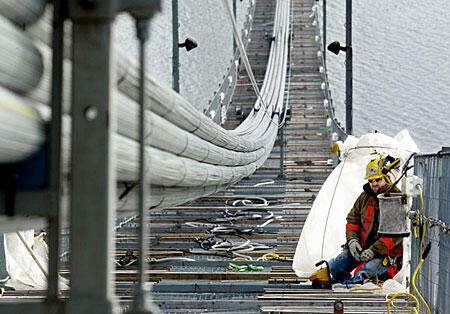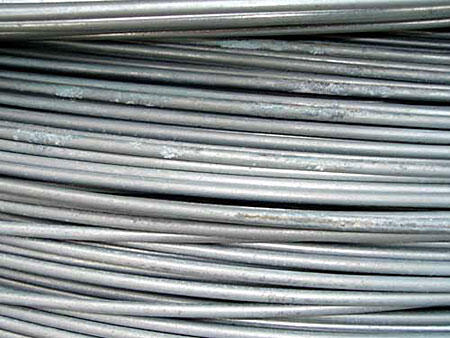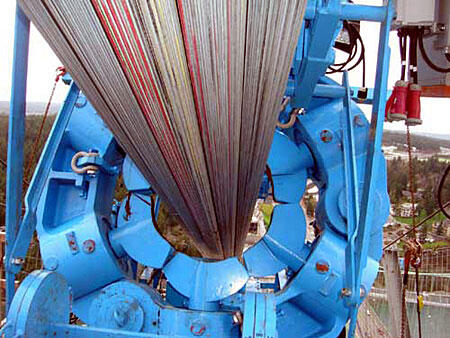Previous posts in the New Narrows Bridge Series:
- The Two Towers I: Introduction
- The Two Towers II: History of the Narrows Bridges
- The Two Towers III: The Caissons
- The Two Towers IV: Anchor Management Class
- The Two Towers V: The Tour Begins
- The Two Towers VI: Struttin’ My Stuff
- The Two Towers VII: To the Top
- The Two Towers VIII: Stairway to Heaven
- The Two Towers IX: Spinning Beginning
For those who may be new to this series, I am blogging the construction of the new Tacoma Narrows Bridge. See the above posts for more information on the Narrows Bridges, the engineering challenges, and a recent first-hand tour taken of the construction site.

The spinning process — laying down over 8800 passes of 0.5 cm steel wire, in 19 bundles, joined end to end into one continuous wire–has been proceeding along without a glitch. Well, almost without a glitch — both cables were being spun at approximately the same rate, until someone noticed that the newer spools of wire coming from the warehouse had a small problem:
Corrosion. Damn!!.
The carbon steel used for the wire, like any steel or iron product, is subject to corrosion — primarily oxidation, better known as rust. Because the oxides of iron are much weaker than the steel itself, this degrades the strength and integrity of steel wire at a rapid rate.
To protect against this process, steel is galvanized — coated with metallic zinc. Zinc will also oxidize, but the oxides of zinc are much more inert and stable, and corrosion of the zinc layer takes far longer than steel.
The zinc is applied to the surface of the steel by one of several processes, including heat fusion, electrolysis, immersion, and painting. These processes form a tight chemical bond between the zinc coating and the underlying steel — a metal alloy or amalgam.
When the wire leaves the plant, the coating is pure metallic zinc. The metallic zinc combines with carbon dioxide and oxygen to form a very stable zinc carbonate protective layer — under ideal conditions. However, when pure metallic zinc is exposed to water (rain or excessive humidity) in an oxygen-poor environment (usually from improper storage), it will react to form zinc hydroxide, or white rust — which is a much poorer corrosion inhibitor, and further inhibits the formation of the more stable carbonate oxides. One spool affected by this process can be seen below:

Now, of course, this presented a small problem: one cannot simple waltz into Home Depot and order up, oh, say, 5,000 miles of high-quality 0.5 cm galvanized steel wire (try putting that on your VISA card… “Can I see your ID, sir?”).
The bridge contract mandated that the project be done by a fixed date, or significant penalties would ensue — so a grand scramble began, and manufacturing sources in South Korea, China, and England were found to manufacture the wire on an emergency basis to make up the difference. Sufficient undamaged wire was on hand to complete the south cable, and about 50% of the north cable.

With the south cable completed, it was time to begin compaction. The individual wires are laid in a geometric pattern, and grouped into bundles or tendons — each comprised of 464 wires, 19 bundles to each cable. The wires are laid in bundles to facilitate their tension adjustment (the tension increasing as more wires, and therefore more weight, is added), and wrapped loosely with fabric tape. These bundles, and their component wires, must now be compressed to form a single cable 20 -1/2 inches in diameter, eliminating all potential space between the wires.
To accomplish this task, the construction crew uses 4 compaction machines, each with 6 hydraulic jacks. These bad boys are capable of generating up to 1200 pounds of combined force.

The compactors were lifted by crane to the east and west side of each tower, and placed around the south cable — one heading toward each anchorage, and two heading toward center span. Their movement downward is passive, using gravity. Riding on wheels on the cable itself, their descent is controlled and braked by cables and pulleys from the towers.

Who said the pocket-protector geek crowd in school weren’t sexy and cool, eh? The dude “encourages” the wires to settle into place as the compactor moves along, caressing their tender flanks with a whack from the ol’ sledge — then checking with the calipers to make sure the diameter is just right.
Very cool.
Well, that’s all for now. Next we’ll lok at banding the cables.
NB: My thanks to the Tacoma News Tribune Archives and the Tacoma Narrows Construction Co. (No longer in business) who provided the photographs.
See also the time sequence construction video from the WA State Dept of Transportation here.